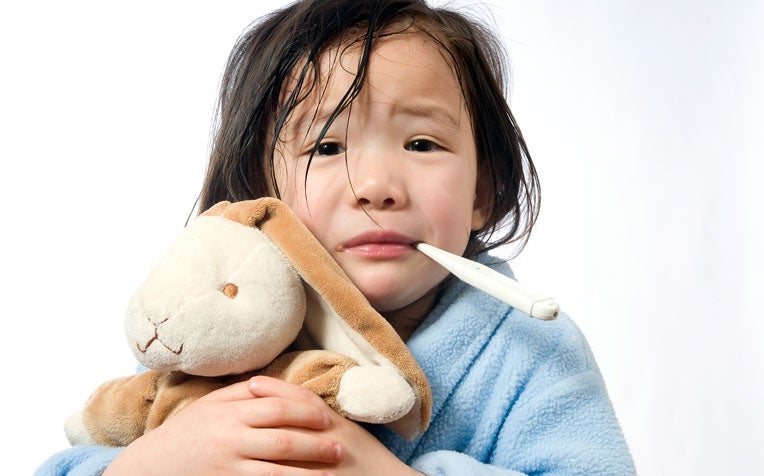
Fever in children does not necessarily signal serious illness.
Babies and children often develop fever, meaning that their body temperature is higher than normal. While it is understandable to feel anxious and worried as a parent, do remember that fever is a sign that something needs to be done and is not a sickness in itself. Fever is sometimes one way that the body fights an infection, and your child’s temperature will return to normal once the infection is treated. So what should you do when your child has a fever?
First of all, it is not accurate to measure a child’s temperature just by feeling the skin with your hands. Temperature is best measured by using a thermometer which can tell you if your child has fever and how high the temperature is.
How do I check my child's temperature for fever?
You can check your child’s temperature in several ways.
In a younger child aged less than 5 years old
You can place a digital thermometer under your child’s armpit (axilla) for a few minutes until the thermometer ‘beeps’ to signal that the temperature is ready for reading. Alternatively you can use the ear (tympanic) thermometer which has a cone-like nozzle that has to be directed towards the middle ear opening to avoid falsely low readings.In the older child aged over 5 years old who can cooperate
You can place the thermometer under (not above) the tongue for a few minutes until it ‘beeps’ to signal that the temperature is ready for reading. In general, glass thermometers containing mercury are no longer recommended because of potential risk of exposure to toxic mercury if it breaks.
What body temperature is regarded as fever in children?
Body temperature varies with age, general health, physical activity, the time of day and thickness of clothing. Everyone's temperature tends to be lower early in the morning and higher between late afternoon and early evening. With strenuous exercise, body temperature will also be slightly higher. Normal body temperature is not a specific number but ranges from 36.1º C to 37.5º C. A temperature of more than 37.5º C may be a mild fever but any temperature exceeding 38º C may potentially be of concern.
How do I make my child more comfortable when he/she has a fever?
Loosen his/her clothing and remove any overlying blankets
Move him/her to a cooler room and switch on the fan. Having a fever may cause some children to feel tired and achy.
Encourage your child to rest as much as desired, preferably in abovementioned cool environment and light clothing.
Encourage your child to drink more fluids, since dehydration can manifest as mild fever. Children with fever may not necessarily feel hungry, so it is not necessary to force them to eat.
Examples of foods you can give include water, milk, pieces of soft fruit (such as watermelon, papaya), diluted fruit juice or milk. Older children may prefer flavored jelly, soups, ice-cream or frozen popsicles. Offer fluids in small amounts more frequently if your child is unable to take a large cup of water. If your child is unwilling or completely unable to drink fluids for more than a few hours, consult your doctor.
You are advised to use tap water (not ice-water) when doing tepid sponging. Alcohol should not be used because of the risk of toxicity if absorbed through the skin. Advise your child to avoid strenuous activities until recovery. You should watch your child for any signs that his or her illness is getting worse.
What causes fever in children?
Fever may be due to an infection, dehydration or inflammation.
Infections in children are more commonly due to viruses than bacteria. Antibiotics are useful treatment against bacterial infections but not against viral infections.
A fever does not necessarily mean that your child has a serious illness.
How high the temperature reaches is not always the best indication whether your child needs to be treated and/or evaluated. Instead, it is important to note how your child behaves and appears.
When do I bring my child to see a doctor for fever?
Your child is less than three months old, regardless of how he/she appears.
The fever is persistent for more than three days.
The fever persists for another three days after your child was started on antibiotics.
Your child looks more sick than before or has not improved over the past 48 hours.
Your child has a history of febrile fits.
Your child has the following symptoms along with fever:
Poor feeding, with or without persistent vomiting
Passes very little urine or wets the diapers less than five times a day
Skin rashes
Looks pale or blue
Breathing difficulty or breathless
Appears ill (eg, fussy, clingy)
Appears drowsy or irritable, or does not seem to recognise you
Has a headache, stiff neck or complains that the light hurts their eyes
Pain e.g. tummy pain
You can consult your baby doctor at the Singapore General Hospital (SGH), Department of Neonatal and Developmental Medicine located at Block 5 Level 1 (OG Center) or any primary healthcare doctor that you are familiar with. When bringing your child for assessment of fever, do inform the doctor of any medications that your child has taken before and if any family member has been ill or travelling.
The next time your child runs a fever, remember these handy tips and always bring him/her to see a doctor when necessary!
Ref: J22
















 Get it on Google Play
Get it on Google Play